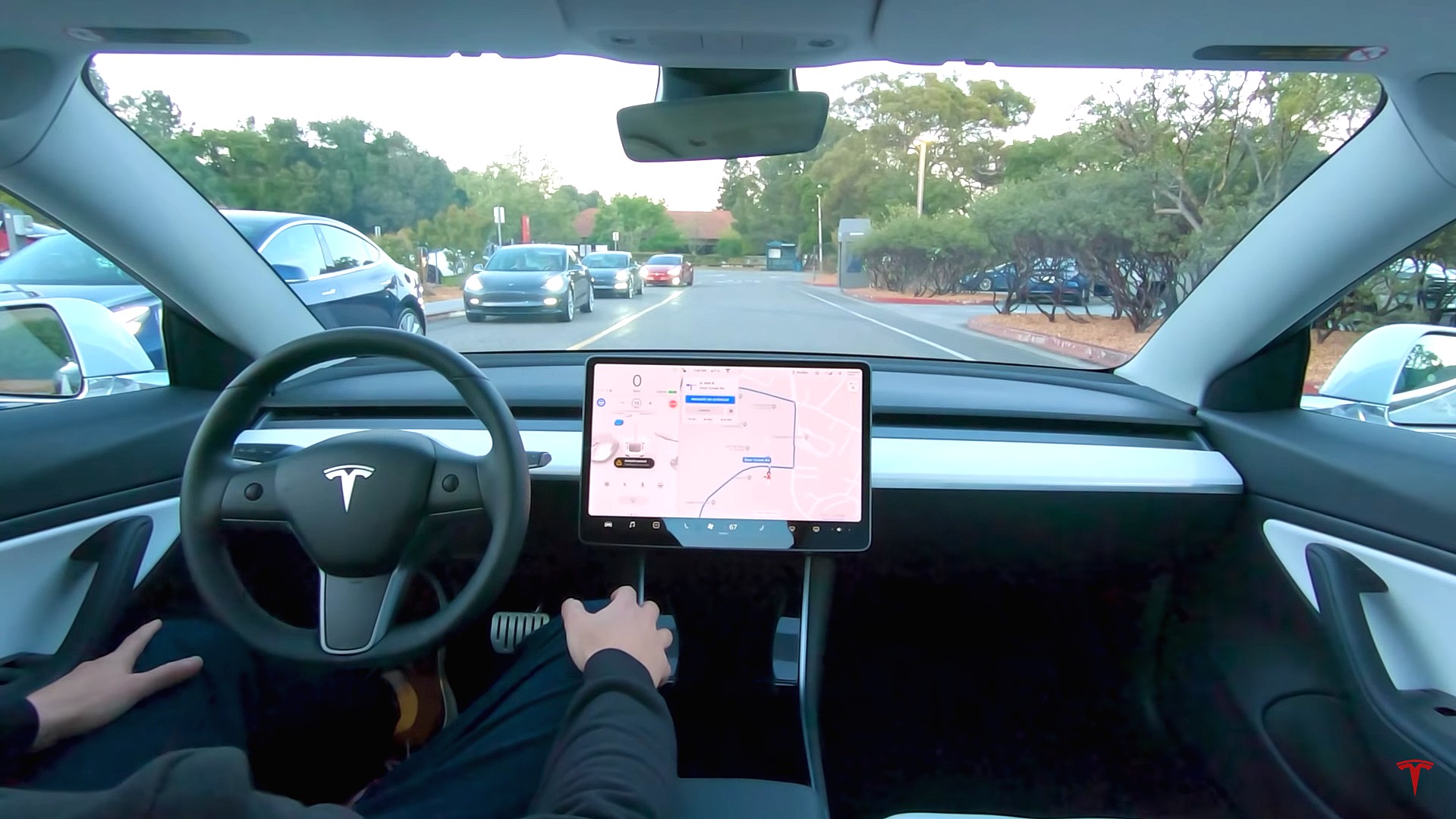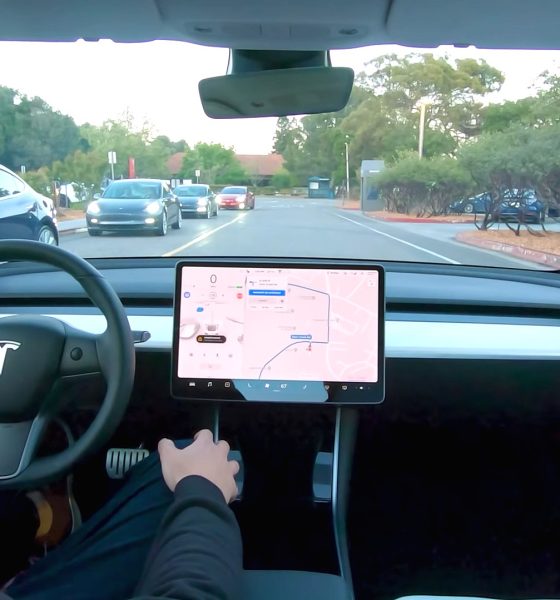

News
Tesla’s in-house Full Self-Driving chip puts TSLA 4 years ahead of competition: analyst
Tesla’s decision to develop its Full Self-Driving (FSD) computer chip in-house has put it four years ahead of the competition, according to ARK Invest analyst James Wang.
Wang laid out the case for the all-electric car maker’s custom automotive-grade computer against the next-best options in the market, all Nvidia products, in an article on ARK Invest’s website. His stated goal in the piece was to clarify Tesla’s position and achievement with full self-driving in simple terms as well as explain why an off-the-shelf chip would not have accomplished the same feat.
Admittedly, Tesla’s Autonomy Day livestream debuting the arrival of its Full Self-Driving computer was chock full of very technical details that many outside the computer science world indicated were difficult to follow. Thus, Wang’s FSD simplification is helpful for gaining insight into Tesla’s autonomous driving progress in terms of the bigger industry picture.
In summary, by focusing only on what its particular needs were for its particular software demands, Tesla was was able to improve its chip’s performance efficiency to a level that has allowed it to “leapfrog” over competitors. Wang predicts that by 2021, Tesla will be ready to release its next generation FSD computer while its closest competitor in terms of optimal peak utilization is just coming to market.
Nvidia is a prominent and highly successful leader in computer chip design, and Tesla already uses its products for Hardware 2.5, the computer currently running the electric car maker’s Autopilot features. That said, the industry giant has three self-driving-focused chips in its lineup: Xavier (in production), Pegasus (readying for production) and Orin (still pending an official announcement).
Pegasus is a Level 5 self-driving computer, as is Tesla’s FSD; however, it has twice as many chips as FSD, consumes seven times more power than FSD, and is too big and expensive for the Model 3. Since Nvidia designs chips for a wide range of hardware manufacturers, much like the Windows and Android operating systems are designed to be flexible enough for different computer and smartphone hardware suites, their functionality cannot be overly streamlined for one system over another. In contrast, Tesla (like Apple hardware/software) can focus all of its autonomy efforts on its specific hardware and software needs, thus achieving a greater output than Nvidia’s product.

In a follow up to Tesla’s Autonomy Day presentation wherein FSD was compared to Nvidia’s Xavier computer, a chip designed for semi-autonomous driving only, the chip manufacturer published a company blog piece drawing attention to Pegasus’ capabilities as a better measure for analysis. As pointed out in Wang’s analysis, the FSD and Pegasus still do not achieve the same metrics, leaving Tesla well positioned amongst its self-driving computer peers. Despite the issue, though, Nvidia’s conclusion was a positive response to the car maker’s achievement: Tesla has raised the bar on self-driving and other car manufacturers need to get on board before falling too far behind.
During the Autonomy Day presentation, Tesla CEO Elon Musk crowned FSD as “objectively best in the world”, and James Wang’s analysis is yet another outline of why that is arguably the case. Tesla’s Full Self-Driving Computer (formerly known as Hardware 3) is currently being installed in all new production vehicles, and owners who purchased Full Self-Driving for a car produced in 2016 or later will receive a free upgrade to the FSD computer in the near future. Musk has further predicted that Tesla’s full self-driving software will be complete by the end of this year and fully operational by the second quarter of next year.

Elon Musk
Elon Musk’s X will start using a Tesla-like software update strategy
The initiative seems designed to accelerate updates to the social media platform, while maintaining maximum transparency.

Elon Musk’s social media platform X will adopt a Tesla-esque approach to software updates for its algorithm.
The initiative seems designed to accelerate updates to the social media platform, while maintaining maximum transparency.
X’s updates to its updates
As per Musk in a post on X, the social media company will be making a new algorithm to determine what organic and advertising posts are recommended to users. These updates would then be repeated every four weeks.
“We will make the new 𝕏 algorithm, including all code used to determine what organic and advertising posts are recommended to users, open source in 7 days. This will be repeated every 4 weeks, with comprehensive developer notes, to help you understand what changed,” Musk wrote in his post.
The initiative somewhat mirrors Tesla’s over-the-air update model, where vehicle software is regularly refined and pushed to users with detailed release notes. This should allow users to better understand the details of X’s every update and foster a healthy feedback loop for the social media platform.
xAI and X
X, formerly Twitter, has been acquired by Elon Musk’s artificial intelligence startup, xAI last year. Since then, xAI has seen a rapid rise in valuation. Following the company’s the company’s upsized $20 billion Series E funding round, estimates now suggest that xAI is worth tens about $230 to $235 billion. That’s several times larger than Tesla when Elon Musk received his controversial 2018 CEO Performance Award.
As per xAI, the Series E funding round attracted a diverse group of investors, including Valor Equity Partners, Stepstone Group, Fidelity Management & Research Company, Qatar Investment Authority, MGX, and Baron Capital Group, among others. Strategic partners NVIDIA and Cisco Investments also continued support for building the world’s largest GPU clusters.
News
Tesla FSD Supervised wins MotorTrend’s Best Driver Assistance Award
The decision marks a notable reversal for the publication from prior years, with judges citing major real-world improvements that pushed Tesla’s latest FSD software ahead of every competing ADAS system.

Tesla’s Full Self-Driving (Supervised) system has been named the best driver-assistance technology on the market, earning top honors at the 2026 MotorTrend Best Tech Awards.
The decision marks a notable reversal for the publication from prior years, with judges citing major real-world improvements that pushed Tesla’s latest FSD software ahead of every competing ADAS system. And it wasn’t even close.
MotorTrend reverses course
MotorTrend awarded Tesla FSD (Supervised) its 2026 Best Tech Driver Assistance title after extensive testing of the latest v14 software. The publication acknowledged that it had previously criticized earlier versions of FSD for erratic behavior and near-miss incidents, ultimately favoring rivals such as GM’s Super Cruise in earlier evaluations.
According to MotorTrend, the newest iteration of FSD resolved many of those shortcomings. Testers said v14 showed far smoother behavior in complex urban scenarios, including unprotected left turns, traffic circles, emergency vehicles, and dense city streets. While the system still requires constant driver supervision, judges concluded that no other advanced driver-assistance system currently matches its breadth of capability.
Unlike rival systems that rely on combinations of cameras, radar, lidar, and mapped highways, Tesla’s FSD operates using a camera-only approach and is capable of driving on city streets, rural roads, and freeways. MotorTrend stated that pure utility, the ability to handle nearly all road types, ultimately separated FSD from competitors like Ford BlueCruise, GM Super Cruise, and BMW’s Highway Assistant.
High cost and high capability
MotorTrend also addressed FSD’s pricing, which remains significantly higher than rival systems. Tesla currently charges $8,000 for a one-time purchase or $99 per month for a subscription, compared with far lower upfront and subscription costs from other automakers. The publication noted that the premium is justified given FSD’s unmatched scope and continuous software evolution.
Safety remained a central focus of the evaluation. While testers reported collision-free operation over thousands of miles, they noted ongoing concerns around FSD’s configurable driving modes, including options that allow aggressive driving and speeds beyond posted limits. MotorTrend emphasized that, like all Level 2 systems, FSD still depends on a fully attentive human driver at all times.
Despite those caveats, the publication concluded that Tesla’s rapid software progress fundamentally reshaped the competitive landscape. For drivers seeking the most capable hands-on driver-assistance system available today, MotorTrend concluded Tesla FSD (Supervised) now stands alone at the top.
News
Elon Musk’s Grokipedia surges to 5.6M articles, almost 79% of English Wikipedia
The explosive growth marks a major milestone for the AI-powered online encyclopedia, which was launched by Elon Musk’s xAI just months ago.

Elon Musk’s Grokipedia has grown to an impressive 5,615,201 articles as of today, closing in on 79% of the English Wikipedia’s current total of 7,119,376 articles.
The explosive growth marks a major milestone for the AI-powered online encyclopedia, which was launched by Elon Musk’s xAI just months ago. Needless to say, it would only be a matter of time before Grokipedia exceeds English Wikipedia in sheer volume.
Grokipedia’s rapid growth
xAI’s vision for Grokipedia emphasizes neutrality, while Grok’s reasoning capabilities allow for fast drafting and fact-checking. When Elon Musk announced the initiative in late September 2025, he noted that Grokipedia would be an improvement to Wikipedia because it would be designed to avoid bias.
At the time, Musk noted that Grokipedia “is a necessary step towards the xAI goal of understanding the Universe.”
Grokipedia was launched in late October, and while xAI was careful to list it only as Version 0.1 at the time, the online encyclopedia immediately earned praise. Wikipedia co-founder Larry Sanger highlighted the project’s innovative approach, noting how it leverages AI to fill knowledge gaps and enable rapid updates. Netizens also observed how Grokipedia tends to present articles in a more objective manner compared to Wikipedia, which is edited by humans.
Elon Musk’s ambitious plans
With 5,615,201 total articles, Grokipedia has now grown to almost 79% of English Wikipedia’s article base. This is incredibly quick, though Grokipedia remains text-only for now. xAI, for its part, has now updated the online encyclopedia’s iteration to v0.2.
Elon Musk has shared bold ideas for Grokipedia, including sending a record of the entire knowledge base to space as part of xAI’s mission to preserve and expand human understanding. At some point, Musk stated that Grokipedia will be renamed to Encyclopedia Galactica, and it will be sent to the cosmos.
“When Grokipedia is good enough (long way to go), we will change the name to Encyclopedia Galactica. It will be an open source distillation of all knowledge, including audio, images and video. Join xAI to help build the sci-fi version of the Library of Alexandria!” Musk wrote, adding in a later post that “Copies will be etched in stone and sent to the Moon, Mars and beyond. This time, it will not be lost.”








